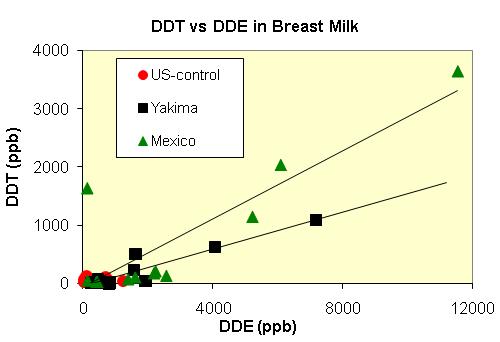About DDE and DDT in breast milk:
DDT is an organochlorine once widely used as a general insecticide,
a compound that is still present in the environment. DDE is a product of biological degradation of DDT. Both DDT and DDE are lipidphilic ("fat
loving") and therefore are concentrated in the breast milk of
mammals, including humans. The
presence of DDT in breast milk represents recent intake of this chemical,
while the presence of DDE reflects longer term exposure. If a nursing mother has consumed a large quantity of DDT during
her life, she may pass this insecticide and its byproduct onto her
infant. Infants are typically far more susceptible
to neurological and developmental damage from toxic chemicals than
adults.
The Yakima River Valley in central Washington
State is one of the most productive agricultural areas on Planet Earth. Large quantities of pesticides, including DDT, have been used
in this region. As a consequence,
many organisms such as bottom-feeding fish in the Yakima River have
very high concentrations of DDT and DDE; DDT is magnified up the food
chain and represents a classic example of bio-amplification. High order consumers such as humans are therefore
at risk for ingesting and accumulating large quantities of DDT and
DDE.
Marien (1998) has examined fish consumption among Hispanics
in the Yakima Valley, to assess the impact of diet on breast milk
and infant exposure to DDT and DDE. Twelve individuals in three different groups were sampled for comparison;
a dozen Mexican Hispanics consuming at least one DDT-contaminated
fish meal per week (referred to as "exposed" individuals),
a dozen US-born unexposed people (non fish-eaters), and a dozen Mexico-born
unexposed individuals. A sample
size of 12 is quite small, and therefore
the uncertainty of the results will be much greater than in a study
with larger samples. However,
increasing the sample size tends to increase the number of extraneous
variables, especially in a complex organism such as a human being. To help mitigate some of this variability, each exposed individual
was matched to two unexposed individuals with the same number of breast-fed
children and the same duration of breast-feeding.
The study results show a wide range of values of both DDE and
DDT in the milk of Yakima Valley Hispanics, regardless of which group
is considered. Why would people within a single group show
such a wide range of contamination? Students should think of several fundamentally different reasons
for the varying levels of DDE and DDT concentration.
Are there differences between the 3 different populations? The students can approach this question a number
of ways, using mean, median, min and max. What might be the cause of these differences between groups? Are the differences statistically significant? Advanced students can use various tests, such
as ANOVA.
What about the effect of fish consumption on DDT and DDE concentration? Why did the unexposed Mexico-born Hispanics
have higher concentrations than the exposed Mexico-born Hispanics?
Sources:
Marien, K (1998), DDT and DDE transmission through breast milk:
Yakima River Basin; Report to the Washington State Dept. of Health,
Office of Environmental Health Assessment Services.
Marien K, Conseur A and Sanderson M (1998), The effect of fish
consumption on DDT and DDE levels in breast milk among Hispanic
immigrants; J. Human Lactation, vol 14, # 3, pp. 237-242.
Many thanks to Koenraad
Marien for providing the original data.
